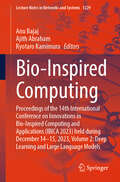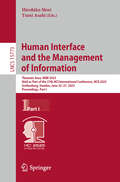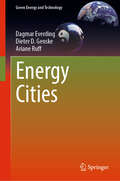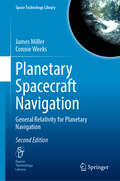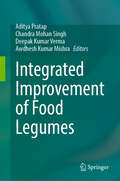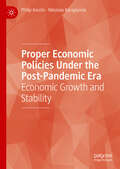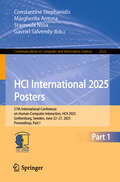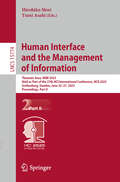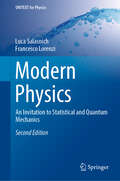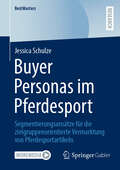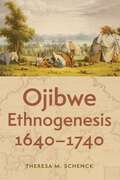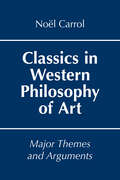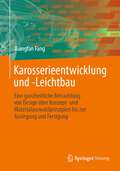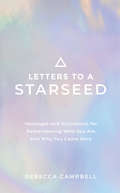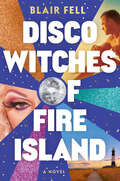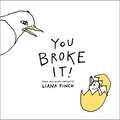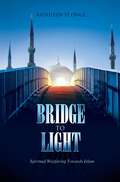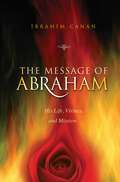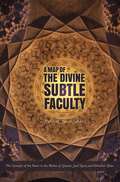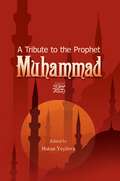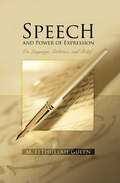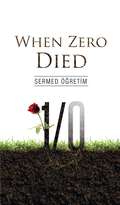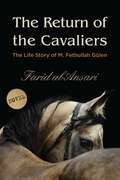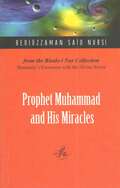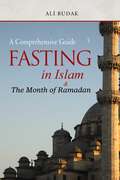- Table View
- List View
Bio-Inspired Computing: Proceedings of the 14th International Conference on Innovations in Bio-Inspired Computing and Applications (IBICA 2023) held during December 14-15, 2023, Volume 2: Deep Learning and Large Language Models (Lecture Notes in Networks and Systems #1229)
by Ajith Abraham Anu Bajaj Ryotaro KamimuraThis book presents 53 selected papers focused on Deep Learning and Large Language Models from the 14th International Conference on Innovations in Bio-Inspired Computing and Applications (IBICA 2023) and 13th World Congress on Information and Communication Technologies (WICT 2023), which was held in five different cities namely Olten, Switzerland; Porto, Portugal; Kaunas, Lithuania; Greater Noida, India; Kochi, India and in online mode. The 23rd International Conference on Hybrid Intelligent Systems (IBICA-WICT 2023) was focusing on synergistic combinations of multiple approaches to develop the next generation of bio-inspired computing and ICT systems. IBICA-WICT 2023 had contributions by authors from 36 countries. This book offers a valuable reference guide for all scientists, academicians, researchers, students, and practitioners focused on advanced machine learning including deep learning methods, large language models, and its real-world applications.
Human Interface and the Management of Information: Thematic Area, HIMI 2025, Held as Part of the 27th HCI International Conference, HCII 2025, Gothenburg, Sweden, June 22–27, 2025, Proceedings, Part I (Lecture Notes in Computer Science #15773)
by Hirohiko Mori Yumi AsahiThe three-volume set LNCS 15773 - 15775 constitutes the thoroughly refereed proceedings of the thematic area Human Interface and the Management of Information, HIMI 2025, held as part of the 27th International Conference on Human-Computer Interaction, HCI International 2025 (HCII 2025), which was held in Gothenburg, Sweden, during June 22–27, 2025. The total of 1430 papers and 355 posters included in the HCII 2025 proceedings was carefully reviewed and selected from 7972 submissions. The papers in these proceedings have been organized in topical sections as follows: Part I: Information design and visualization; human-human and human-AI collaboration; user experience design and evaluation; Part II: Information in eHealth; information, knowledge and learning; Part III: Multimodality and information; eCommerce and industrial applications.
Energy Cities (Green Energy and Technology)
by Dieter D. Genske Dagmar Everding Ariane RuffWith cities and regions moving away from fossil-nuclear energy sources, the importance of energy-ecological urban transformation is growing. A growing number of stakeholders are committed to transitioning energy supplies to renewable sources and promoting resource-efficient ecological cycles in their communities. Energy-ecological urban transformation directly improves living and environmental conditions in neighborhoods, creates new economic opportunities, and generates jobs. Cities are being transformed into 'energy cities' that adhere to the principles of sustainability, minimizing energy-ecological footprints, and reducing land consumption. This book envisions future scenarios of urban transformation for stakeholder discourse. It provides a cross-disciplinary description of urban planning, engineering, and economic approaches to energy-ecological urban transformation, including methodological solutions. Numerous interesting project examples are presented to illustrate these concepts. The target audience for this book includes municipal administrations and climate protection managers, planning and engineering firms, environmental organizations, as well as students and educators.
Planetary Spacecraft Navigation: General Relativity for Planetary Navigation (Space Technology Library #45)
by James Miller Connie WeeksIn this new edition, the authors James Miller and Connie Weeks dive deeper into how computer programming has assisted with planetary spacecraft navigation; evaluating real-world results and relying on complex mathematical theory to observe advancements made in this rapidly accelerating field. This textbook introduces the theories and practical procedures used in planetary spacecraft navigation. Written by a former member of NASA's Jet Propulsion Laboratory (JPL) navigation team with his co-author, it delves into the mathematics behind modern digital navigation programs, as well as the numerous technological resources used by JPL as a key player in the field. In addition, the text offers an analysis of navigation theory application in recent missions, with the goal of showing students the relationship between navigation theory and the real-world orchestration of mission operations.
Integrated Improvement of Food Legumes
by Aditya Pratap Deepak Kumar Verma Chandra Mohan Singh Awdhesh Kumar MishraGrain legumes provide an excellent source of dietary protein, carbohydrates, iron and zinc. Their role in promoting human and soil health, and environmental sustainability, is appreciated by the global scientific communities. Impressive research progress has been made on the development of improved varieties, matching production and protection technologies, biofortification and post-harvest management of food legumes. The genetic improvement has been, due in large part, to the advent of modern molecular and genomic technologies which have supplemented the traditional methods and classical breeding. This book brings together a comprehensive knowledge resource on all such developments and provides information on next generations breeding approaches, improvement of quality traits, multiple stress resistance, seed quality enhancement and post-harvest processing and value addition in grain legumes.It is intended to be a comprehensive guide to legume crops improvement and cultivation.
Proper Economic Policies Under the Post-Pandemic Era: Economic Growth and Stability
by Philip Arestis Nikolaos KaragiannisThis book examines the economic challenges facing the United States, the United Kingdom, and the European Monetary Union and discusses the macroeconomic policies pursued by their authorities in detail. It highlights a range of unsuccessful monetary and fiscal policies to establish financial stability and reduce inflation. By assessing the current threats to economic growth and stability, alternative ways in which governments and central banks can create coordinated responses and deliver better economic and social outcomes are outlined. The implications of Artificial Intelligence and cryptocurrencies are also discussed. This book offers a practical framework for realistic modern economic policy that produces economic and environmental sustainability. It will be relevant to students, academics, researchers, and policymakers interested in the political economy, international economics, and economic policy.
HCI International 2025 Posters: 27th International Conference on Human-Computer Interaction, HCII 2025, Gothenburg, Sweden, June 22–27, 2025, Proceedings, Part I (Communications in Computer and Information Science #2522)
by Gavriel Salvendy Margherita Antona Constantine Stephanidis Stavroula NtoaThe eight-volume set, CCIS 2522-2529, constitutes the extended abstracts of the posters presented during the 27th International Conference on Human-Computer Interaction, HCII 2025, held in Gothenburg, Sweden, during June 22–27, 2025. The total of 1430 papers and 355 posters included in the HCII 2025 proceedings were carefully reviewed and selected from 7972 submissions. The papers presented in these eight volumes are organized in the following topical sections: Part I: Virtual, Tangible and Intangible Interaction; HCI for Health. Part II: Perception, Cognition and Interaction; Communication, Information, Misinformation and Online Behavior; Designing and Understanding Learning and Teaching experiences. Part III: Design for All and Universal Access; Data, Knowledge, Collaboration, Research and Technological Innovation. Part IV: Human-Centered Security and Privacy; Older Adults and Technology; Interacting and driving. Part V: Interactive Technologies for wellbeing; Game Design; Child-Computer Interaction. Part VI: Designing and Understanding XR Cultural Experiences; Designing Sustainable (Smart) Human Environments. Part VII: Design, Creativity and AI; eCommerce, Fintech and Customer Behavior. Part VIII: Interacting with Digital Culture; Interacting with GenAI and LLMs.
Human Interface and the Management of Information: Thematic Area, HIMI 2025, Held as Part of the 27th HCI International Conference, HCII 2025, Gothenburg, Sweden, June 22–27, 2025, Proceedings, Part II (Lecture Notes in Computer Science #15774)
by Hirohiko Mori Yumi AsahiThe three-volume set LNCS 15773 - 15775 constitutes the thoroughly refereed proceedings of the thematic area Human Interface and the Management of Information, HIMI 2025, held as part of the 27th International Conference on Human-Computer Interaction, HCI International 2025 (HCII 2025), which was held in Gothenburg, Sweden, during June 22–27, 2025. The total of 1430 papers and 355 posters included in the HCII 2025 proceedings was carefully reviewed and selected from 7972 submissions. The papers in these proceedings have been organized in topical sections as follows: Part I: Information design and visualization; human-human and human-AI collaboration; user experience design and evaluation; Part II: Information in eHealth; information, knowledge and learning; Part III: Multimodality and information; eCommerce and industrial applications.
Modern Physics: An Invitation to Statistical and Quantum Mechanics (UNITEXT for Physics)
by Luca Salasnich Francesco LorenziThis textbook offers an introduction to statistical mechanics, special relativity, and quantum physics, developed from lecture notes for the "Quantum Physics" course at the University of Padua. Beginning with a brief review of classical statistical mechanics in the first chapter, the book explores special and general relativity in the second chapter. The third chapter delves into the historical analysis of light quantization, while the fourth chapter discusses Niels Bohr's quantization of energy levels and electromagnetic transitions. The Schrödinger equation is investigated in the fifth chapter. Chapter Six covers applications of quantum mechanics, including the quantum particle in a box, quantum particle in harmonic potential, quantum tunneling, stationary perturbation theory, and time-dependent perturbation theory. Chapter Seven outlines the basic axioms of quantum mechanics. Chapter Eight focuses on quantum atomic physics, emphasizing electron spin and utilizing the Dirac equation for theoretical justification. The ninth chapter explains quantum mechanics principles for identical particles at zero temperature, while Chapter Ten extends the discussion to quantum particles at finite temperature. Chapter Eleven provides insights into quantum information and entanglement, and the twelfth chapter explains the path integral approach to quantum mechanics.
Buyer Personas im Pferdesport: Segmentierungsansätze für die zielgruppenorientierte Vermarktung von Pferdesportartikeln (BestMasters)
by Jessica SchulzeIm Marketingalltag wird immer wieder deutlich, dass die Potenziale der eingesetzten Marketinginstrumente nicht in vollem Umfang ausgeschöpft werden. Hierbei fällt besonders auf, dass es in der Branche des Pferdesports schwerfällt, einzelne Zielgruppen zu identifizieren und diese spezifisch zu bearbeiten. In diesem Buch werden nicht nur geeignete Modelle, Kriterien und Prozesse für die Marktsegmentierung<span lang=DE style='font-size:11.0pt;mso-fareast-font-family:"PT Sans"'><span style='mso-element:field-begin'> XE "Marktsegmentierung" <span lang=DE style='font-size:11.0pt;mso-fareast-font-family:"PT Sans"'><span style='mso-element:field-end'> von Käufern verschiedener Pferdesportartikel eruiert, sondern auch die einzelnen Kundengruppen im Pferdesport analysiert. Mit Hilfe einer konkreten und bildhaften Beschreibung werden diese schlussfolgernd in plastische und verständliche Persönlichkeitsbilder – sogenannte Buyer Personas<span lang=DE style='font-size:11.0pt; mso-fareast-font-family:"PT Sans"'> XE "Buyer Personas" <span lang=DE style='font-size:11.0pt;mso-fareast-font-family:"PT Sans"'><span style='mso-element:field-end'> – übersetzt. Es geht darum, Herstellern, Anbietern und anderen Marketing-Managern aus der Pferdesport-Branche einen Mehrwert auf wissenschaftlicher Basis zu liefern und das doch recht besondere Marketing im Pferdesport ein Stück weit transparenter zu machen.
Ojibwe Ethnogenesis, 1640–1740
by Theresa M. SchenckIn Ojibwe Ethnogenesis, 1640–1740 Theresa M. Schenck (Ojibwe, Huron, and Blackfeet) presents the first scholarly work to untangle the origin, rise, and spread of Ojibwe identity and culture from the mid-seventeenth to mid-eighteenth centuries, as well as the emergence of Ojibwe identity in the early years of French imperial incursions into the Upper Midwest. Schenck traces the names ascribed to the Ojibwe by French officials, traders, missionaries, and settlers in the earliest European records to their presences in French America. Schenck then follows the people themselves and their complex relationships through the centuries. Schenck&’s proficiency in French and her close reading of the sources, many in French, have facilitated a more accurate, traceable, and comprehensive documentary study than achieved by previous generations of scholars. Ojibwe Ethnogenesis, 1640–1740 has thus achieved our fullest understanding to date of Ojibwe roots and culture going back four hundred years.
Classics in Western Philosophy of Art: Major Themes and Arguments
by Prof. Noël CarrollIn this synthetic introduction to the history of the philosophy of art, Noël Carroll elucidates and analyzes selected writings on art by Plato, Aristotle, Hutcheson, Hume, Kant, Hegel, Schopenhauer, Tolstoy, and Bell. Carroll&’s narrative tracks developments between major positions in philosophy of art, ranging from the idea that art is unavoidably embedded in society to the evolution of the notion that art is autonomous ("art for art&’s sake"), thereby setting the stage for continuing debates in the philosophy of art.Presupposing no prior background, and useful on its own or accompanying the reading of primary works, Classics in Western Philosophy of Art is ideal as a text for introductory undergraduate and graduate courses in philosophy of art and aesthetics, or for anyone interested in learning about the origin of some of our most fundamental conceptions of art in the Western tradition.
Karosserieentwicklung und -Leichtbau: Eine ganzheitliche Betrachtung von Design über Konzept- und Materialauswahlprinzipien bis zur Auslegung und Fertigung
by Xiangfan FangDas Buch behandelt alle wissenschaftlichen und technischen Aspekte der Karosserieentwicklung und des Karosserieleichtbaus. Es ist an Studierende der Fahrzeugtechnik und Ingenieure der Karosserieentwicklung in der Automobil- und Zuliefererindustrie adressiert, die das Thema erlernen, vertiefen und in den F&E Arbeiten einsetzen möchten. Hierzu soll ein umfassender und gleichzeitig tiefergehender Einblick in die Karosserieauslegung, -konstruktion, -berechnung und -fertigung sowie -Leichtbau vermittelt werden. Dabei wird zunächst großer Wert darauf gelegt, die mechanischen Grundprinzipien der Struktur analytisch zu verstehen. Damit sollen Ingenieure in der Lage sein, die Karosseriestruktur auch zunächst ohne FEM konzeptionell auszulegen. Ein weiteres wichtiges Ziel ist, die Wechselwirkungen zwischen den konstruktiven Konzepten für die Karosseriestruktur mit den aktuellen und zukünftigen Werkstoffen und den damit verbundenen Fertigungstechniken systematisch zu verknüpfen. Dabei werden analytische Methoden der Materialauswahl für den Leichtbau auf Grundlage der Mechanik erläutert. Darüber hinaus werden ausgehend von den theoretischen Grundlagen viele praktische Umsetzungsbeispiele mit unterschiedlichen Lösungsansätzen von verschiedenen OEMs aufgezeigt. Der Leser soll damit einen guten Überblick über die Karosserieentwicklung und den Leichtbau erhalten. Das Buch soll nicht nur den Stand der Technik wiedergeben, sondern auch den Leser zum Nachdenken zu eigenen Lösungen anregen. Es soll damit als ein nützliches Werkzeug für den Entwickler in der Automobil- und Zuliefererindustrie dienen.
Letters to a Starseed: Messages and Activations for Remembering Who You Are and Why You Came Here
by Rebecca CampbellAn inspirational guide for understanding your soul and discovering why it chose to incarnate at the moment it did.From the author of The Starseed Oracle, Rebecca Campbell, a writer, mystic, devotional creative, and visionary who supports hundreds of thousands of people to connect with their soul and weave the sacred back into their everyday life.&“A leading voice in spirituality, Rebecca's work is deep and illuminating.&”— Soul and Spirit MagazineAN ENCOURAGING BOOK TO HELP YOU REMEMBER WHO YOU ARE AND TO PLANT YOURSELF HERETap into the cosmic nature of your soul, discover your purpose and commit to being here on Earth.Letters to a Starseed asks the biggest questions that mystics and philosophers through the ages have been asking: What is the soul, where did it originate and why have we chosen to come here at this time?YOUR SOUL HAD A DREAM, YOUR LIFE IS IT.This is a book for those who at times feel misplaced in the world; those who have always felt a remembering of some other place without quite knowing what that place really is.As a planet, we are waking up to the fact that the ancient prophecies and warnings from the elders and wise ones are no longer predictions, but our waking reality. They are not just coming or even near ... we are living them right now.What we do now matters to the future of this planet. And we all have a role to play.Some Letters to a Starseed Chapter Titles include:· Who Are We and Where Did We Come From?· The Moment of Your Birth· What Is a Starseed?· Ancient Stars in Our Bones· Reaching Back to the Ancients· Here We Are· Returning· The Longing for Home· I Remember· Why Did You Come Here?· There Must Be More Than This· Why Did You Choose to Come?· We All Have a Role to Play, but Only We Know What· Our Role Is· There You Are· I Have Music in My Heart· Finding Our Ground· Starseed Roles· Plant Yourself Here· How to Feel More at Home on Earth· The Challenge of Being Human· Incarnation· The Original Severing· Plant Yourself HereWe are living in a time between myths and stories, and are currently re-weaving the fabric of life on Earth. Throughout this book, Rebecca shares insights and experiences illuminating the connection between our souls, the Earth and the cosmos, to encourage you to commit fully to your incarnation, embrace your human experience and plant yourself here.&“Throughout the book you&’ll find two prompts, which will support you on your journey as you read.&“In many chapters, you&’ll find Soul Inquiry prompts that will help you hear the calls of your soul as you journey through the book.&“In some chapters, you&’ll also find activations. These are here to support you in activating and integrating energies and healing within you, from your soul to your cells.&“My hope for this book is that it supports, comforts, and inspires you to remember who you truly are and why you chose to be here at this pivotal moment in the story of humanity. To commit fully to being here and being present to your life on Earth at this time.&“To encourage you to play the note that you came here to play, without waver.&“Do you remember why you&’ve come?&”Love,Rebecca x
Disco Witches of Fire Island: A Novel
by Blair Fell&“Heartfelt.&”—The New York TimesHit the dance floor with a coven of queer witches on 1980s Fire Island in this gay fantasy romance about finding magic, love, and family in the face of tragedy. A heartwarming LGBTQ+ novel for fans of steamy romance, loathe-at-first-sight, and Red, White, and Royal Blue. The paperback edition will have sprayed teal edges and foil on the cover!It&’s 1989, and Joe Agabian and his best friend Ronnie set out to spend their first summer working in the hedonistic gay paradise of Fire Island Pines. Joe is desperate to let loose and finally move beyond the heartbreak of having lost his boyfriend to the HIV/AIDS epidemic.The two friends are quickly taken in by a pair of quirky, older house cleaners. But something seems off, and Joe starts to suspect the two older men of being up to something otherworldly. In truth, Howie and Lenny are members of a secret disco witch coven tasked with protecting the island—and young men like Joe—from the relentless tragedies ravaging their community. The only problem is, having lost too many of their fellow witches to the epidemic, the coven&’s protective powers have been seriously damaged.Unaware of all the mystical shenanigans going on, Joe starts to fall for the super-cute bisexual ferryman who just happens to have webbed feet and an unusual ability to hold his breath underwater. But Joe&’s longing to find love is tripped up by his own troublesome past as well as the lure of a mysterious hunk he keeps seeing around the island—a man Howie and Lenny warn may be a harbinger of impending doom. The Disco Witches need to find help—fast—if they&’re to save Joe and the island from the Great Darkness. But how? Fans of spicy queer romances with a dash of fantasy will fall in love with this stunning novel of community, love, sex, magic, and hope in desperate times.
You Broke It!
by Liana FinckFrom acclaimed New Yorker cartoonist Liana Finck comes a clever and validating twist on parent-child dynamics.This collection of classic parental nags are cleverly betrayed by the situations shown, in which it&’s made clear that the child knows better. Each scenario is worthy of a giggle, adding a lightheartedness to the inevitable dynamics between parents and children. Cartoonist Liana Finck has created a catharsis for her own childhood memories of knowing better than authority figures, and in doing so, validates young readers with the respect and understanding they deserve.
Bridge To Light
by Kathleen OngeAddressed to Muslims in western societies and to non-Muslims interested in learning about the religion, this portrait of contemporary Islam uses simple terms to show how Islam crosses boundaries of language and culture. Arguing that it has relevant answers for problems in industrial societies, the book describes the moral code of the Qur''an as humane and rational and emphasizes the historical bridges that connect Islam to Judaism and Christianity. For practicing Muslims, the book advises on how best to navigate western culture without compromising traditional values.
Message Of Abraham
by Ibrahin CananProphet Abraham, peace be upon him, plays a key role in interfaith dialogue activities, for he is considered the patriarch of all divinely revealed religions. The Message of Abraham explores his example through many of his outstanding virtues, his investigation of faith, his willingness to worship the Divine alone, his regard for nature, his hospitality, compassion, and devotion to God, the One and Only. Although the book presents the Islamic standpoint with respect to the teachings and message of Prophet Abraham, there are also many references to the Biblical sources about his life. Learning about Abraham and his mission is significant in a globalized world where distances have shrunk and everyone has almost become neighbor to one another.
A Map of the Divine Subtle Faculty: The Concept of the Heart in the Works of Ghazali, Said Nursi, and Fethullah Gulen
by Mehmet Yavuz SekerThe heart in the Islamic understanding is the expression of a human being's spiritual existence. It is a Divine gift and Divine subtle faculty bestowed upon humanity. It is a polished mirror reflecting God. Like a general, the heart commands all other bodily organs and faculties, which are its troops, Everything that comes from a human being, whether good or bad, is a product of the heart. Mehmet Y. Seker, a scholar of Sufism and tasawwuf, studies the concept of the heart in the Islamic tradition looking at how it is approached by three prominent scholars and thinkers of Islam: Ghazali, Said Nursi, and Fethullah Gulen. Being the first in English to take as its focus the human heart from an Islamic spiritual, this book comparatively analyzes classical and modern age interpretations and evaluations on the concept and adds to the rich literature of spirituality in the Islamic tradition.
A Tribute to the Prophet Muhammad
by Hakan KosovaDedicated to the memory of Islam's Prophet Muhammad on the occasion of his birthday, this book includes articles that discuss various aspects of the Prophet and Islam's fundamental concepts. Presented in this reference is the arguement that it is time for both Muslims and non-Muslims to restore the image of Prophet Muhammad as a role model and father and to overcome the common prejudices associated with Islam's leader.
Speech And Power Of Expression
by M. Fethullah GülenEmphasizing the esthetic concerns of the Islamic civilization as well as underlining the true nature of the religion, this insightful opus contains a collection of essays on the art of language from a revered contemporary scholar of Islam. Written separately as lead articles for the Turkish literary magazine, Yagmur, the volume eloquently articulates the author&’s approach to speech as well as his definitions of poetry, history, and beauty, all of which are deeply embroidered around the lacework of Islam. With powerful emphasis on belief in God, each essay addresses an important matter of language that aptly relates to the current state of affairs in the Muslim world and the nature of human existence in the 21st century as a whole.
When Zero Died
by Sermed OgretimAn old man shares his secret for happiness. The two halves of the brain debate the meaning of life. A young man explains why he chose life over death. An explorer and his team are trapped in a hostile environment, the fate of their extremely important mission in doubt. A common tradesman must solve an unanswered question to win the love of a princess; he seeks the answer with a reclusive hermit deep in the mountains. The stories in When Zero Died aren&’t ordinary: They draw on some of the oldest, classic forms in storytelling—allegory and myth—to explore what it means to live a thoughtful, selfless life in a chaotic, selfish world. They blur the line between science and religion to show how deeply interconnected the world, and everything in it, really is. Full of sharp intelligence, humor, and pathos, When Zero Died will make you think about how perfectly ordered and designed the universe is, and will force you to re-consider how you live your own life.
The Return of the Cavaliers: Biography of Fethullah Gulen
by Farid Al AnsariBeginning with the environment in which Fethullah Gulen was raised and the dynamics that formed his character, this biographical novel captures the very essence of his exemplary life story by shedding light on the crucial events and memories that left their mark in the lives of Gulen and the dedicated philanthropic people inspired by him. The life of Fethullah Gulen, a prominent Turkish Muslim scholar and a source of inspiration for millions, is a life of epic struggle for the sublime cause he is devoted to. There was no change in his disposition and resolve although he was tested with the most severe hardships and persecutions throughout his life. It is an inspiring story of tears, painful displacements, migrations, perseverance, endurance, and triumph.
Prophet Muhammad And His Miracles
by Bediuzzaman Said NursiProminent scholars of Islam say that the evidence of Prophet Muhammad&’s Prophethood and his miracles amounts to about 1000. Countless people have affirmed it in their own particular ways, and the Qur&’an itself provides thousands of such proofs. This book by Bediuzzaman Said Nursi talks about some of the extraordinary incidents that happened during the time of Prophet Muhammad, peace and blessings be upon him, in support of his Divine mission, that is, calling people to Islam. Bediuzzaman Said Nursi is one of the most influential scholars of Islam in modern Turkey.
Fasting In Islam And The Month Of
by RamadanaliThis book seeks to explore the divine institution of fasting in Islam by providing comprehensive information on its place in the Islamic doctrine and on the month of Ramadan in which fasting is observed. Major topics include fasting in Islam and other faiths; merits and benefits of fasting; types of fasts; charity in Ramadan; fasting and health. Fasting in Islam is a well-written introduction book that lays down the basics of fasting as practiced by Muslims.
